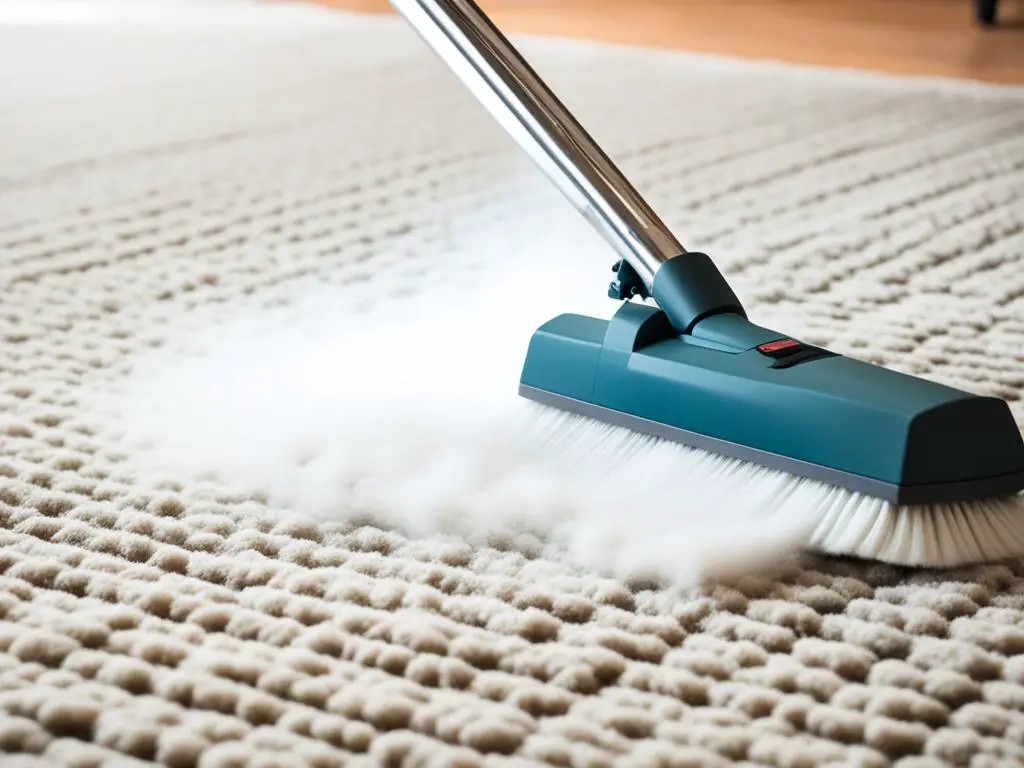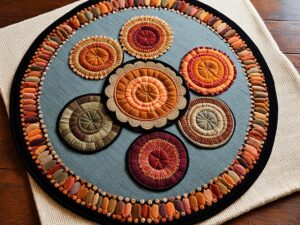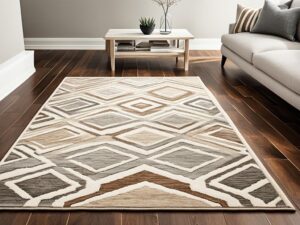Vacuuming your wool rug is crucial for its longevity and maintaining cleanliness. Regular vacuuming helps remove dirt and debris from the rug, protecting the delicate wool fibers. In this expert guide, we will walk you through the proper techniques and tips for vacuuming your wool rug to ensure effective care and maintenance.
Key Takeaways:
- Regular vacuuming is essential for the longevity of wool rugs.
- Vacuuming helps remove dirt and debris from the rug, protecting the delicate wool fibers.
- Proper techniques and tips are important for effective care and maintenance of wool rugs.
- Understanding the different types of wool rugs is crucial for selecting the appropriate vacuuming techniques.
- Additional care tips, such as minimizing exposure to high-traffic areas and periodic professional cleaning, help maintain the beauty of wool rugs.
Why Vacuuming is Important for Wool Rugs
Vacuuming your wool rug is essential for maintaining its longevity and preserving its beauty. Wool rugs act as excellent air filters, trapping dust, allergens, and other particles that can accumulate over time. Regular vacuuming helps to remove these contaminants, improving indoor air quality and creating a healthier living environment.
Furthermore, proper vacuuming prevents the buildup of dirt and debris in the rug’s fibers. Over time, this buildup can cause wear and tear, damaging the delicate wool fibers and affecting the rug’s appearance and durability. By incorporating regular vacuuming into your wool rug care routine, you can effectively remove dirt and debris, thereby reducing the risk of fiber damage and extending the time between professional cleanings.
Proper vacuuming also helps to maintain the rug’s overall cleanliness. Dust, dirt, and allergens can settle deep into the rug’s fibers, becoming more challenging to remove if left unchecked. Regular vacuuming prevents these particles from settling in, ensuring that your wool rug remains clean and free from potentially harmful substances.
Remember, vacuuming is just one part of a comprehensive wool rug care routine. In addition to regular vacuuming, it’s important to address spills promptly, rotate the rug periodically, and consider professional cleaning when necessary. By following these care tips, you can enjoy the beauty and durability of your wool rug for years to come.
Understanding Different Types of Wool Rugs
When it comes to cleaning and maintaining wool rugs, it’s crucial to understand their unique characteristics and construction. Different types of wool rugs, such as woven, tufted, and shag rugs, require specific care and vacuuming techniques to ensure their longevity and preserve their beauty.
Woven Wool Rugs
Woven wool rugs are known for their intricate patterns and durability. They usually have visible knots on the back, which is a result of the weaving process. When vacuuming a woven wool rug, it’s important to use a vacuum cleaner with adjustable suction and brush settings. Focus on suction rather than aggressive brushing to avoid damaging the delicate fibers. Vacuuming in the direction of the weave can help keep the rug in optimal condition.
Tufted Wool Rugs
Tufted wool rugs are popular for their plush and luxurious feel. They have a latex backing, which holds the tufted fibers in place. To properly vacuum a tufted wool rug, it’s best to avoid using a beater brush as it can pull on the tufted loops and loosen them. Instead, opt for the upholstery attachment of your vacuum cleaner for gentler cleaning. Vacuuming in a slightly angled direction across the rug can help remove dirt and maintain its appearance.
Shag Wool Rugs
Shag wool rugs are known for their long pile fibers, providing a cozy and inviting texture. When vacuuming a shag wool rug, it’s important to use a vacuum cleaner with a brush-less setting or adjust the brush settings to the highest level. This will prevent tangling or damaging the long fibers. It’s also recommended to vacuum in a gentle back-and-forth motion, allowing the vacuum to pick up dirt and debris without pulling on the fibers.
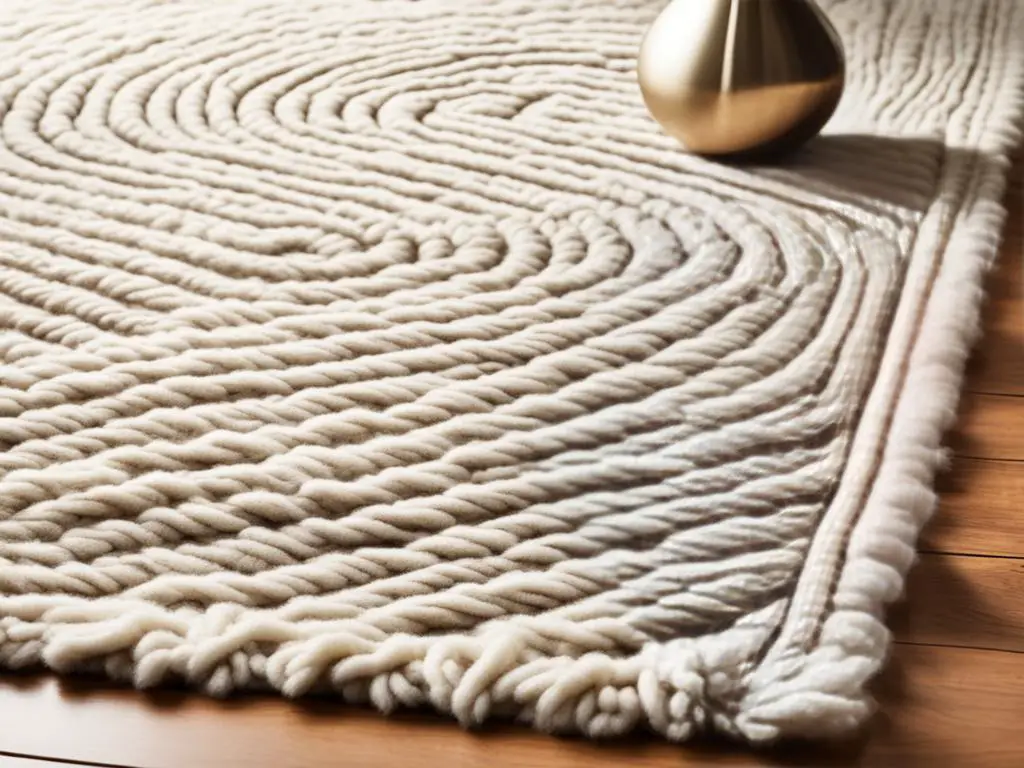
“Understanding the construction of your wool rug is the first step in effective maintenance. Whether it’s a woven rug with visible knots, a tufted rug with a latex backing, or a shag rug with long pile fibers, choosing the right vacuuming technique is essential for preserving its beauty and longevity.”
– Rug Care Experts
Vacuuming Techniques for Wool Rugs
Vacuuming your wool rug is an important part of its care and maintenance. However, it’s crucial to use the proper techniques to avoid damaging the delicate fibers. Here are some recommended vacuuming techniques for different types of wool rugs:
1. Woven Rugs:
For woven rugs, it’s best to use an upright vacuum with adjustable suction and brush settings. Focus on suction rather than aggressive brushing to protect the fibers. Vacuum in the direction of the pile to prevent fiber damage.
2. Tufted Rugs:
To vacuum tufted rugs, avoid using the beater brush as it can pull out the tufts. Instead, opt for the upholstery attachment or a vacuum with a gentle suction setting. This will allow you to clean the rug without causing any damage.
3. Shag Rugs:
When vacuuming shag rugs, it’s important to use a brush-less vacuum or adjust the brush settings to the highest level. This will prevent the long pile fibers from getting tangled or damaged during cleaning.
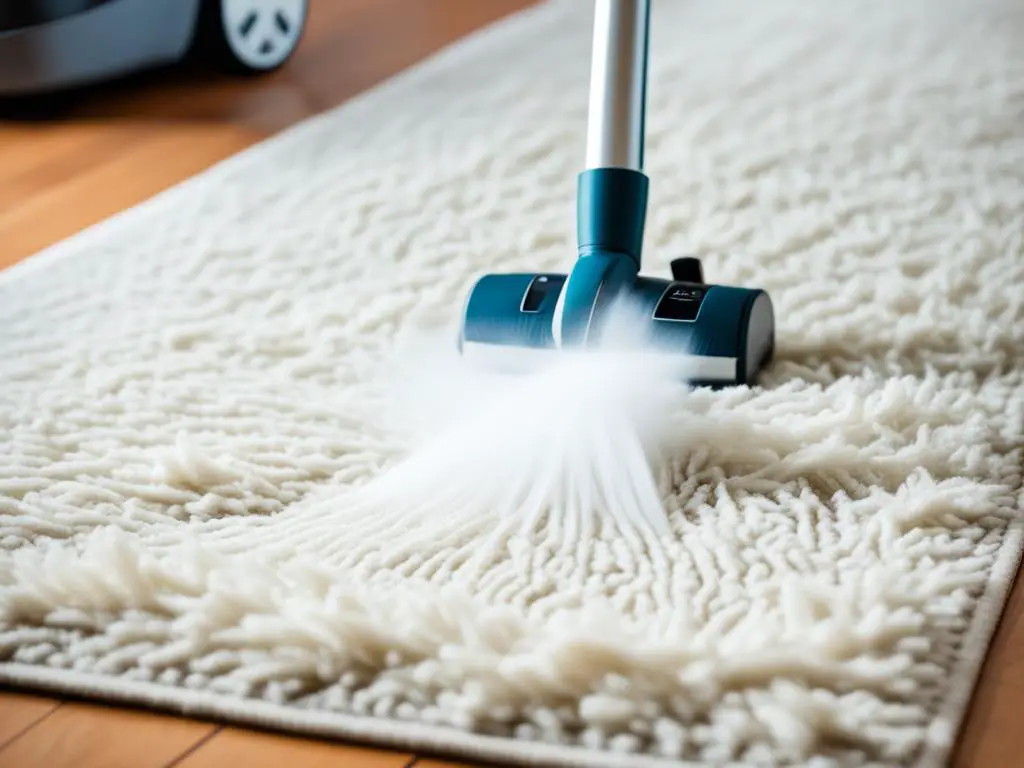
Remember, no matter the type of wool rug, always vacuum in the direction of the pile, as this helps maintain its appearance and prevents fiber damage. By following these vacuuming techniques, you can keep your wool rug clean and well-maintained for years to come.
| Type of Wool Rug | Vacuuming Technique |
|---|---|
| Woven | Use an upright vacuum with adjustable suction and brush settings. Vacuum in the direction of the pile. |
| Tufted | Avoid the beater brush. Opt for the upholstery attachment or a gentle suction setting. |
| Shag | Use a brush-less vacuum or adjust the brush settings to the highest level. |
Tips for Effective Wool Rug Vacuuming
To ensure effective vacuuming of your wool rug, consider these tips:
- Treat vacuuming as dusting and make it a regular part of your cleaning routine. By vacuuming your wool rug frequently, you can prevent the buildup of dirt and debris, keeping it clean and fresh.
- Avoid using a beater bar or rotating brush attachment while vacuuming your wool rug. These aggressive brushing actions can damage the delicate wool fibers and cause fraying or shedding.
- Vacuum both sides of the rug to remove any embedded dirt and debris. Flip the rug over and repeat the vacuuming process, ensuring thorough cleaning and preventing dirt from settling into the fibers.
- Adjust the vacuum settings based on the thickness and construction of your wool rug. If your rug has a low pile or is more delicate, lower the suction power and avoid high-speed brush rotations. For thicker rugs, use higher suction power and adjust the brush settings accordingly.
- Regularly clean the back of the rug to remove dust and debris that may accumulate over time. Use the upholstery attachment or a handheld vacuum to gently vacuum the underside of the rug.
- Pay attention to the fringes and side binding of your wool rug. These areas can accumulate dirt and dust, so use the appropriate vacuum attachments to clean them. Be careful to avoid tangling or pulling the fringes, as it can cause damage.
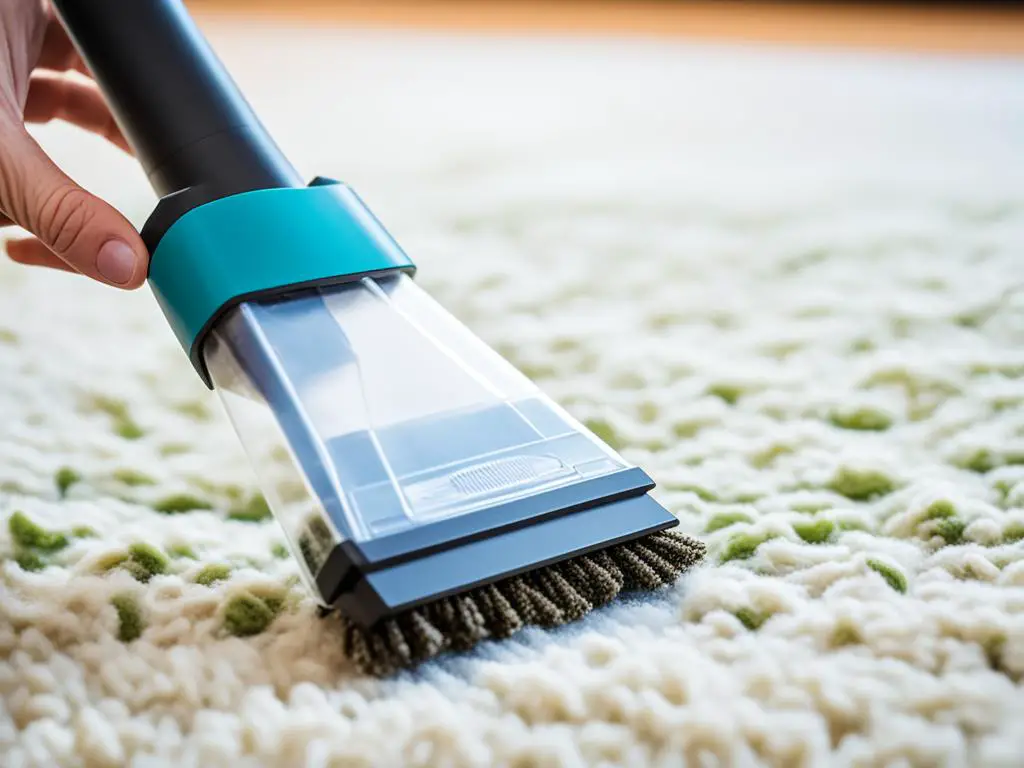
By following these tips, you can ensure that your wool rug remains clean, fresh, and well-maintained for years to come.
Additional Care Tips for Wool Rug Maintenance
Along with regular vacuuming, there are other care tips that can help you maintain the beauty and longevity of your wool rug. By following these guidelines, you can ensure that your rug remains in top condition for years to come.
Minimize Exposure to High-Traffic Areas and Moisture
High-traffic areas of your home can quickly wear down the fibers of your wool rug. To prevent excessive wear and tear, consider placing your rug in areas with lower foot traffic or using rugs runners in high-traffic hallways. Additionally, avoid placing wool rugs in areas prone to moisture, such as near entryways or in bathrooms, as excess moisture can lead to mold and mildew growth.
Use a Rug Pad
Using a rug pad is a simple yet effective way to protect your wool rug. Rug pads provide cushioning under your rug, reducing wear and tear from foot traffic. They also help prevent your rug from slipping and sliding on hard floors. Furthermore, rug pads reduce friction between your rug and the floor, minimizing the risk of damage or color transfer.
Blot Spills Immediately
Accidents happen, and when spills occur on your wool rug, it’s important to act quickly. Use a clean cloth or paper towel to blot the spill immediately, absorbing as much liquid as possible. Avoid rubbing the spill, as this can push the liquid deeper into the fibers and spread the stain. For stubborn stains, use a mild detergent specifically formulated for wool rugs and follow the manufacturer’s instructions.
Rotate the Rug Periodically
Rotating your wool rug every few months helps distribute the wear more evenly, preventing specific areas from becoming overly worn or faded. This practice is particularly important in high-traffic areas where the rug receives the most foot traffic. By rotating the rug, you can extend its lifespan and maintain a consistent appearance.
Consider Professional Cleaning
While regular vacuuming can remove surface dirt, professional cleaning is necessary to remove deep-seated dirt and allergens from your wool rug. It’s recommended to have your rug professionally cleaned every one to two years, depending on its condition and usage. Professional cleaning not only refreshes the rug’s appearance but also helps maintain its overall health and cleanliness.
| Care Tip | Description |
|---|---|
| Minimize Exposure | Avoid high-traffic areas and moisture-prone locations in your home. |
| Use a Rug Pad | Provide cushioning, prevent slipping, and reduce friction with a rug pad. |
| Blot Spills Immediately | Act fast and blot spills with a clean cloth to prevent stains. |
| Rotate the Rug | Periodically rotate the rug to distribute wear evenly. |
| Professional Cleaning | Schedule professional cleaning to remove deep-seated dirt. |
How to Vacuum Different Types of Wool Rugs
Proper vacuuming techniques vary depending on the type of wool rug. Here’s a guide to help you vacuum your wool rug effectively:
Flat Weave Rugs
When vacuuming flat weave rugs, use a vacuum with enough suction to capture dirt and debris. However, it’s important to avoid using the beater brush, as it can damage the rug’s delicate fibers. Instead, opt for the upholstery attachment or a suction-only mode for gentle cleaning.
Handmade Rugs
Handmade wool rugs require extra care during vacuuming. Unless advised by professionals, it’s best to avoid using the beater brush, which can cause the rug’s fibers to loosen or break. Instead, use the upholstery attachment or a vacuum with adjustable settings for a safer cleaning experience.
Tufted Rugs
Tufted wool rugs tend to shed more easily, so it’s essential to use the right vacuuming technique. Avoid using the beater brush and opt for the upholstery attachment or a vacuum with suction-only mode. This will help prevent excessive shedding and maintain the rug’s overall appearance.
Machine-Made Rugs
Machine-made wool rugs are generally more durable and can withstand the use of a beater brush. However, it’s important to avoid vacuuming the fringes, as they may get tangled or damaged. Adjust the vacuum settings to a suitable level and ensure a thorough cleaning without causing any harm to the rug.
Silk, Cotton, Viscose, or Artificial Silk Rugs
Rugs made of delicate materials like silk, cotton, viscose, or artificial silk require extra caution when vacuuming. Never use the beater brush, as it can easily damage these fibers. Instead, use the upholstery attachment, gently glide the vacuum over the rug, and ensure a light touch to avoid any potential harm.
Synthetic Fiber Rugs
Most synthetic fiber rugs can tolerate the use of a beater brush. However, it’s always wise to check with professionals or the manufacturer’s guidelines to ensure compatibility. Adjust the vacuum settings accordingly and maintain a regular cleaning routine to keep your synthetic fiber rug looking its best.
Remember, proper vacuuming techniques are crucial for maintaining the beauty and longevity of your wool rug. By employing the appropriate method for each rug type, you can effectively remove dirt, debris, and allergens while preserving the rug’s natural fibers and overall appearance.
Conclusion
In conclusion, proper vacuuming techniques are crucial for the care and maintenance of your wool rug. Regular vacuuming helps to remove dirt, dust, and debris, protecting the delicate wool fibers and preserving the rug’s beauty. By following the right techniques and tips, such as using the appropriate vacuum attachments and adjusting the settings based on the rug’s construction, you can ensure effective cleaning without causing any damage.
Aside from vacuuming, it’s important to incorporate other care tips into your wool rug maintenance routine. Minimizing high-traffic areas and preventing exposure to moisture can help in prolonging the rug’s lifespan. Using a rug pad adds cushioning and prevents slipping, while blotting spills immediately and rotating the rug regularly can prevent permanent stains and reduce wear. Additionally, considering professional cleaning every one to two years can help remove deep-seated dirt and restore the rug’s appearance.
In conclusion, maintaining your wool rug’s longevity and appearance requires a combination of regular vacuuming, proper care, and periodic professional cleaning. By investing time and effort into the care and maintenance of your wool rug, you can enjoy its beauty for years to come.
